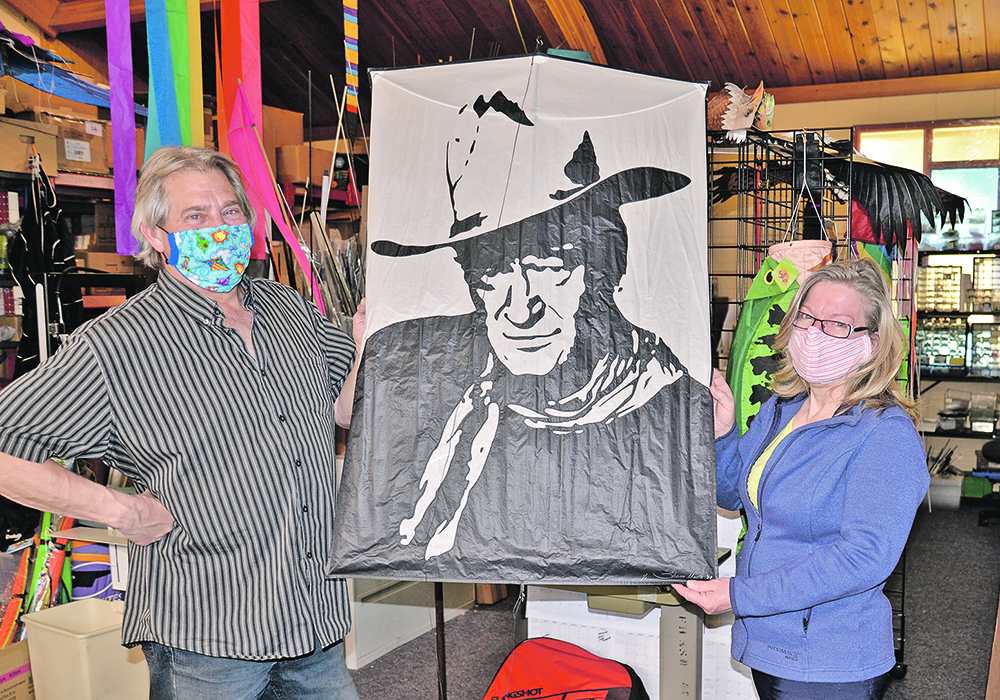BENTLEY, Alta. —Bud Taylor doesn’t have to be told twice to go fly a kite. He’s been passionate about it since childhood.
The Kite Guys store and studio he owns and operates with Sharon Musto in central Alberta is the culmination of that pursuit.
There are thousands of kites in the 2,500 sq. foot store, with a vaulted ceiling reaching seven-metres high, providing an airy space to showcase dozens of bright, beautiful kites.
“It’s this building that brought us to Bentley,” says Taylor. That was in 2016.
Read Also

Nutritious pork packed with vitamins, essential minerals
Recipes for pork
The structure was previously a church, but dwindling numbers of parishioners and increasing operating costs forced it to close and it was sold in 2014.
“We bought it lock, stock, and barrel,” says Taylor. “The pews were still here. They’re a beautiful solid oak.”
The Kite Guys sell many different types of kites, including delta, diamond, parafoil, cellular, sled, stunt, traction, and rokkaku, a Japanese fighter kite. They’ve got single, dual and quad line kites.
Most are made of tear-resistant ripstop nylon. Some have appliquéd graphics, others are printed. Some kites are designed to allow people to build at home, others can be decorated.
The Kite Guys also accepts custom orders and offers flags, banners, windsocks and garden spinners.
Taylor says it is Canada’s largest, full-service kite store.

“No one has come forward to challenge me on that.”
The couple usually attend about 10 kite festivals or trade shows a year but all are cancelled this year due to COVID-19.
Of all their previous travels, one of their most unforgettable experiences happened in 2007. The couple attended the Cygnet’s Centennial, the 100th anniversary celebration honouring Alexander Graham Bell’s 3,393-cell tetrahedral kite, the Cygnet, at his historic Beinn Bhreagh estate in Baddeck, N.S.
“It was incredible” says Taylor. “I stood where Alexander Graham Bell stood.”
The couple were further honoured when asked to create a Canadian-made limited edition Maple Leaf Kite for the Alexander Graham Bell National Historic Site Museum Store at Baddeck.
The couple have also shown their craft on television, having supplied kites for episodes of the Bachelorette and Heartland.
In the past, they’ve offered instruction sessions for schools and corporate groups and they’re now considering what that will look like post COVID-19.
“Kite flying teaches so much,” says Musto.
It provides fun without overwhelming students with technical details of aerodynamics, physics, and engineering.
“We talk a bit about those things in laymen’s terms,” says Taylor. “They pick it up fast.”
Kiting promotes the creation of art and exercise, but the couple most appreciate the intangibles.
“Freedom. Joy. Innocence,” says Musto. “There’s just so much symbolism attached.”
It’s those qualities that drew Taylor to the sport.
“I learned from my dad, my grandfather, and my Aunt Cookie.”
He recalls the exhilaration of flying kites in the northern Alberta skies above Fox Creek with his younger brother, Scott.
“We’d go out in April in our rubber boots and run over the snow.”
“We built our own kites from newspaper and sticks; from bedsheets and nylons.”
Taylor said the bedsheets were torn up to become bowties on the nylon stocking tail.
“As for string, we’d use whatever we could get our hands on.”
By 1989 they were living in Cochrane, Alta. Bud married and worked in oil and gas fields, and Scott attended art and design college in nearby Calgary.
Together, they started Rocky Mountain Kite and Sport.
In 1992, Bud quit the oilpatch. He and Scott were determined to turn their kite hobby into careers.
“I decided if I was going to get into this, I needed to learn everything I could about it.”
They read every kite book and magazine they could and travelled the country seeking out kite enthusiasts.
“We started buying kites and taking them apart and figuring out how to make them,” says Taylor.
“We sent a survey out to about 500 kite stores in the (United States).”
The goal was to determine the viability of their dream business. Taylor said the overriding response was negative, but the brothers were not deterred and Rocky Mountain Kite and Sport carried on.
They never grew tired of attending a school or community event and many times they heard somebody enthusiastically welcome them and announce, “The kite guys are here.”
This prompted a change to the business name.
In 2006, Scott died.
Around the same time Taylor, single and living in Airdrie, Alta., met Musto at a kite festival. They eventually became a couple — in life and in business.
Musto got into kites in 1995, after graduating with a teaching degree from the University of Manitoba in Winnipeg.
“It was a really good stress reliever. I couldn’t afford to buy a kite. So I got hold of one, a rokkaku, and copied it,” she says. “It flew out of my hands the very first time.”

















